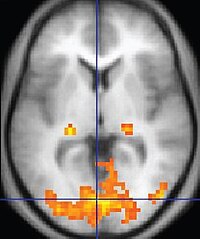
Photo from wikipedia
BACKGROUND Wave gradient encoding can adequately utilize coil sensitivity profiles to facilitate higher accelerations in parallel magnetic resonance imaging (pMRI). However, there are limitations in mainstream pMRI and a few… Click to show full abstract
BACKGROUND Wave gradient encoding can adequately utilize coil sensitivity profiles to facilitate higher accelerations in parallel magnetic resonance imaging (pMRI). However, there are limitations in mainstream pMRI and a few deep learning (DL) methods for recovering missing data under wave encoding framework: the former is prone to introduce errors from the auto-calibration signals (ACS) signal acquisition and is time-consuming, while the latter requires a large amount of training data. PURPOSE To tackle the above issues, an untrained neural network (UNN) model incorporating wave-encoded physical properties and deep generative model, named WDGM, was proposed with additional ACS- and training data-free. METHODS Generally, the proposed method can provide powerful missing data interpolation capability using the wave physical encoding framework and designed UNN to characterize the MR image (k-space data) priors. Specifically, the MRI reconstruction combining physical wave encoding and elaborate UNN is modeled as a generalized minimization problem. The designation of UNN is driven by the coil sensitivity maps (CSM) smoothness and k-space linear predictability. And then, the iterative paradigm to recover the full k-space signal is determined by the projected gradient descent, and the complex computation is unrolled to the network with optimized parameters by the optimizer. Simulated wave encoding and in vivo experiments are exploited to demonstrate the feasibility of the proposed method. The best quantitative metrics RMSE/SSIM/PSNR of 0.0413, 0.9514, and 37.4862 gave competitive results in all experiments with at least six-fold acceleration, respectively. RESULTS In vivo experiments of human brains and knees showed that the proposed method can achieve comparable reconstruction quality and even has superiority relative to the comparison, especially at a high resolution of 0.67 mm and fewer ACS. In addition, the proposed method has a higher computational efficiency achieving a computation time of 9.6 s/per slice. CONCLUSIONS The model proposed in this work addresses two limitations of MRI reconstruction in the wave encoding framework. The first is to eliminate the need for ACS signal acquisition to perform the time-consuming calibration process and to avoid errors such as motion during the acquisition procedure. Furthermore, the proposed method has clinical application friendly without the need to prepare large training datasets, which is difficult in the clinical. All results of the proposed method demonstrate more confidence in both quantitative and qualitative metrics. In addition, the proposed method can achieve higher computational efficiency.
Journal Title: Medical physics
Year Published: 2023
Link to full text (if available)
Share on Social Media: Sign Up to like & get
recommendations!